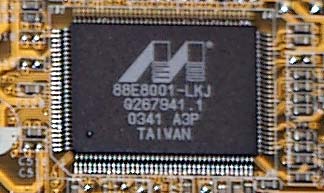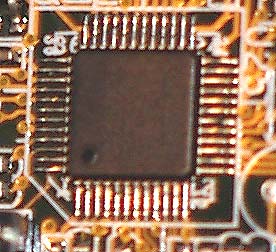Asus P4S800D-E Deluxe & Gigabyte 8S655TX Ultra: SiS 655TX Challenges Intel's Best
by Wesley Fink on December 9, 2003 1:52 PM EST- Posted in
- Motherboards
Asus P4S800D-E: Features and Board Layout
In addition to the feature set provided by the 655TX, Asus adds a number of additional features.
This is the first use of the SiS 180 RAID controller on a production motherboard. It appears that the 180 is ideally matched to extend the capabilities of the on-ship SATA of the 964 South Bridge. Asus provides up to 2 additional SATA ports plus another IDE port for up to 2 additional IDE drives. The four SATA and IDE devices can be configured as regular devices or as RAID 0, 1, 0+1, or JBOD (spanning, literally “just a bunch of drives”). The unified SiS 964/180 driver controls both the 964 and 180 drives, simplifying installation.

Gigabit LAN is provided by the Marvel chip; the first time we have seen Asus use this Ethernet chip.

In the continuing upgrades to on-board audio, Asus uses the high-quality Analog Devices SoundMax AD1888 codec to supply 6-channel audio. This is the same chip that Asus uses on all their upper end boards, and it is the chip pioneered by Intel on their top 875 boards along with the auto-jack-sensing feature. A Coaxial SPDIF out jack is provided on the rear panel for Dolby Digital setups. More information on the SoundMax audio codec is available at http://www.soundmax.com/.

I/O port offerings on the P4S800D-E are excellent. They include the PS2 ports, SPDIF out, Parallel, Serial, Firewire, 4 USB 2.0 ports, Gigabit LAN, and 3 mini jacks with auto-sensing for up to 6 external speakers. The auto-sensing feature is nice, but keep in mind that with 6 speakers connected, you will no longer have a MIC port available in this configuration.
Board Layout

The Asus P4S800D-E is full-size ATX design with plenty of room for an effective layout of the on-board options. The basic layout of the board is outstanding, with only 2 minor complaints.
First, although the 20-pin ATX connector is in our preferred upper right position, the 4-pin 12 volt connector is to the left of the CPU socket and near the midline of the board. This means that the 12-V cable must be snaked around the CPU and it is not the best location for most case designs. We probably have to go back to SiS with this complaint, since it seems to be carried over from the Reference board. The second item is the location of the on-board audio connectors. If you need to use an audio connector for your DVD/CD, the location at the lower left of the board will be a challenge for running cables. We generally prefer a location above the slots for the audio connectors — it makes it easier to route audio cables.
The IDE connectors, IDE RAID, and 4 SATA connectors are all in good locations. The edge-connector floppy is about midline and worked fine, but we usually like it a bit higher for tower cases that put the floppy at the top. All-in-all, there is a lot to like on this board layout, and not many complaints.

It is good to see that Asus is also using color-coded panel connectors. We first saw these on a Gigabyte board and they do make deciphering these connections a lot easier.










24 Comments
View All Comments
bigtoe33 - Tuesday, December 9, 2003 - link
#1The board actually supports 128bit or dual 64bit mode from what i remember looking at the bios.
dvinnen - Tuesday, December 9, 2003 - link
errrr, #2, lay off the weed.valnar - Tuesday, December 9, 2003 - link
Everybody has to remember that SiS is only marginally better than VIA in compatibility, and several degrees less than any Intel modern chipset..
This makes SiS an excellent option for AMD based motherboards, but why on Earth would you pair an Intel processor with anything other than an Intel chipset? The whole point of paying the $$ for an Intel CPU is the benefit of getting to use their chipset. Works with everything, always.
.
That's worth the extra $20.
FishTankX - Tuesday, December 9, 2003 - link
Did I miss something? IN the conclusion it said it packs dual channel 128 bit DDR?